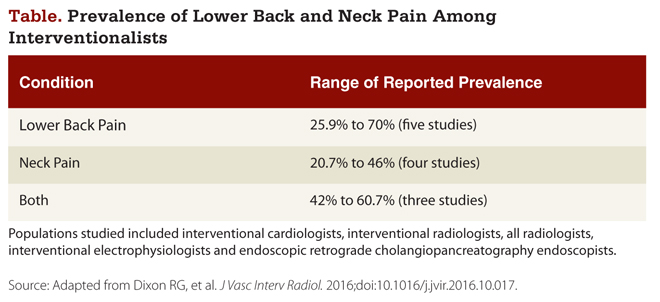5 Things All Vascular Specialists Should Be Concerned About in US Health Care
Vascular interventionalists face pressure from many fronts in today’s U.S. health care environment. The challenges are physical, financial, bureaucratic and even emotional.
What follows is a characterization of five of the things I most worry about for our profession: occupational health, compensation, hospital stability, professional autonomy and, perhaps most daunting of all, burnout.

Occupational Health
Repeatedly performing vascular interventions can be extraordinarily difficult on an operator’s body. Although we are trying to improve the health of people with peripheral artery disease, critical limb ischemia, carotid artery disease, abdominal aortic aneurysms and other conditions, we can compromise our own health if we are not careful.
A major concern is orthopedic neck and back problems due to lead aprons. According to published reports, approximately 50% of interventionalists said they have spine and/or back problems serious enough to limit work (Table); this is double the rate reported in the general population.

Another serious problem is radiation exposure. The risk models indicate that any radiation dose carries with it an associated risk for cancer induction, and that risk increases linearly with ascending dose. In other words, the longer we expose ourselves to radiation, the greater the chance we contract cancer.
In addition, signals from small samples suggest an increased risk for hematologic and brain cancers in operators with long-term exposure to radiation.
Interventionalists also appear to be at elevated risk for cataract formation, and the safe cumulative dose is not known.
In a review of occupational hazards, published in Catheterization and Cardiovascular Interventions,Cardiology Today’s Intervention Editorial Board Member Lloyd W. Klein, MD, FSCAI, FACC, and colleagues wrote, “Interventional physicians and their professional societies, working together with industry, should strive toward the ultimate zero-radiation-exposure work environment that would eliminate the need for personal protective apparel and prevent its orthopedic and ergonomic consequences.”
Compensation
Compensation and reimbursement issues have grown more challenging for vascular interventionalists in recent years.
In the current era of cost containment, there is continuous downward pressure from payers on hospitals and physicians.
The Medicare Access and CHIP Reauthorization Act, known as MACRA, replaced the Medicare reimbursement schedule with a scheme based on pay-for-performance principles that emphasize quality, accountability and value. The Merit-based Incentive Payment System, known as MIPS, is used to derive a composite performance score that determines whether a clinician receives a payment bonus, a payment penalty or no adjustment. It is based on quality, resource use, clinical practice improvement and meaningful use of electronic health records technology. Alternative payment models are now used to provide incentives to giving high-quality and cost-efficient care in specific conditions or populations.
These structures are now increasingly dictating how interventionalists get paid, especially as the population ages and more patients are covered by Medicare instead of commercial payers.
Hospital Stability
More doctors are moving under the purview of hospitals as opposed to private practices while the stability of hospitals is coming into question due to decreasing revenue and increasing costs.
On the revenue side, there is downward reimbursement pressure across the board; a worsening payer mix due to more patients aging into Medicare; a Medicaid expansion that has been better than nothing but still not greatly helped coverage of lower-income patients; and large insurance deductibles for patients, which has led to more of them not paying their hospital bills.
However, there are cost pressures such as pressure to retain nursing staff with higher wages and higher costs for so-called “physician preference” items.
Further threatening the stability of hospitals is conglomerates such as Amazon, Apple, Berkshire Hathaway, Cigna, Verily and Walmart attempting to expand into health care delivery.
Professional Autonomy
As concerns have grown about the long-term health of hospitals, interventionalists and other clinicians have been required to make trade-offs, which often come in the form of giving up professional autonomy.
Gone are the days when interventionalists could use whatever products they liked, when they liked. In many cases, supply-chain savings now have to be factored into those decisions.
Interventionalists now must also consider value over volume. There is more emphasis on following appropriate use criteria to ensure that procedures are performed when they are most likely to improve outcomes. Readmissions have become an important quality metric to determine compensation, so interventionalists are under pressure to reduce them.
Public reporting programs have increased transparency while interventionalists also feel pressure to meet patient satisfaction metrics, which creates a conflict between doing what patients want vs. what they need.
Perhaps most importantly, clinicians’ time is increasingly being taken with EHRs, which were designed with billing in mind, not ease of use for patient care.
Burnout
Health hazards, uncertainty about compensation, instability of institutions, loss of professional autonomy and other factors can ultimately lead down a road that no one wants to travel: physician burnout.
It is not going to get any easier to practice medicine. Clinicians are no longer as confident in the health care system as they used to be because of regulatory and compliance issues that divert their attention from patient care. They are being asked to do more with less and are feeling that they have little influence over the future state of medicine.
If these trends continue, too many interventionalists will leave their profession due to burnout. We need system-wide solutions to prevent that from happening before disaster strikes.
- References:
- Dixon RG, et al. J Vasc Interv Radiol. 2016;doi:10.1016/j.jvir.2016.10.017.
- Klein LW, et al. Catheter Cardiovasc Interv. 2018;doi:10.1002/ccd.21772.
- For more information:
- Christopher J. White, MD, MSCAI, FACC, FAHA, FESC, FACP, is chief of medical services; medical director for system service lines and system chairman for cardiology at Ochsner Medical Center, New Orleans; professor and chairman of medicine at the University of Queensland-Ochsner Clinical School; and a member of the Cardiology Today’s Intervention Editorial Board. He can be reached at Ochsner Medical Center, 1514 Jefferson Highway, New Orleans, LA 70121; email: cwhite@ochsner.org.
Disclosure: White reports no relevant financial disclosures.

